Musée des Acadiens des Pubnicos

Arriving from the South Shore Side of Nova Scotia, the Pubnico Acadian Museum is a little ways into the town. We thought we were almost out of town when we came upon it. Here, we were welcomed with homemade Harvest Hamburger Soup from Bernice dEntremont and her husband, Réal. Since that soup, we have done so much together in one evening and one morning, it is impossible to not remain friends for life!

I believe that our experience, though unique in that Bernice made a very special effort to cater to my interests and show us around her home town, is one that anyone can have visiting this area. The people are real. (Especially, Réal…haha.) They are open, warm, friendly and understand the word “interdependence”. They understand the importance of community, family, tradition, and history. They are committed to honouring their past and they work hard at whatever they undertake. This is a very small, very industrious village with a huge chunk of Canadiana residing in this small space… and in each heart of every Acadian villager of Pubnico.
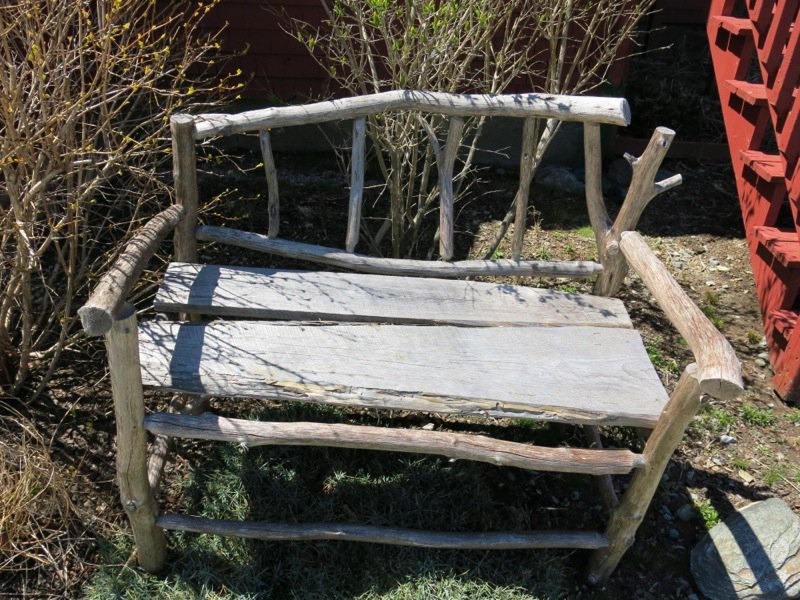
I was tempted. It is inviting. The day was quiet and still. The moment, rare.

The anchor is such a symbolic artifact on this front lawn. This town is a fishing village. Everything in this village now revolves completely around the lobster fishing industry… and these people are steeped in history. They have anchored in Pubnico and are well-anchored in their Acadian culture and beliefs. They stand still in rough waters. They know who they are, from whence they came and live in the lap of those that came before. They appreciate and intimately understand the sacrifices made by their predecessors for each of them. The Acadian people of Pubnico share a heritage that few could ever understand in this new world. And I had no idea we had a village of Canadian Acadians that have lived in the same place for generations… and there are three such Acadian Villages, though this is the oldest.

Breakfast at The Dennis Point Café, a tour of d’Eons Rappie Pie, a tour of the Acadian Historic Village, and here we are and it is only 10 am. How did all this fit into one morning? (Have you ever met Bernice d’Entremont? She is the miracle maker in this town.) The Museum was a bundle of activity on this morning. Gals were quilting and chatting and working on an assortment of hand crafts.

From left to right: Bernice d”Entremont, her sister-in-law, Denise d’Eon, Sharon Murphy, Jean d’Eon, Gladys Swim, followed by Paulette d’Entremont Surette. These gals all came for tea and biscuits just because I was visiting. What an honour! Enroute to the Museum from the Village, Bernice managed to whisk me to the Windmills so I could see how massive they are, and they are the biggest I have ever seen – then stopped by a gal’s house to pick up warm biscuits to share with everyone, above. Apparently, Elaine Surette is the best biscuit maker in Pubnico. She uses her grand-mama’s recipe. Some Pubnico biscuit makers may disagree, but I would not be one of them. These were the best biscuits I have eaten! (Sorry mom.)

Warm, with butter and homemade jam amid great company added to the flavour of this treat this fine morning… and thank you very much for making them!
I have never been one for jams or jellies. I make them every year, yet never eat them. However, this trip, with biscuits around every corner and at every meal, and berries I had never tasted, I do believe I have changed my ways. There were some jams that I could not get enough of. The Gooseberry Jam made right here at the Museum with the berries grown in the Museum garden, harvested while green (not yet ripe), was to-die-for. (Maybe I say that too often.) I found out they sold it in the Museum store and was not leaving without buying a jar. However, I did: there was so much happening on this morning. I have not forgotten the taste of that jam or this lovely coffee clatch!



You may think I am overdoing it with the photos of the jams and the biscuits, but you did not taste them!
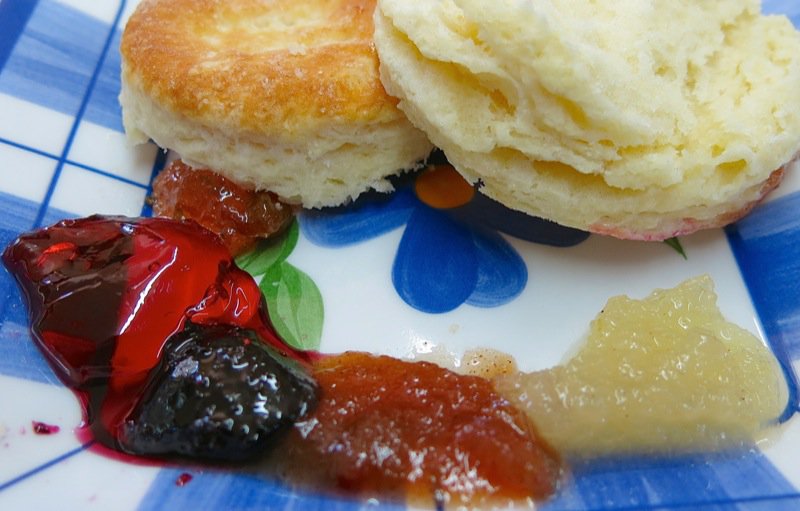

These gals have so many projects on the go at this place, there is nary a time for idle hands. They work on their own quilts at home and community quilts here. They sell them to people. They work together on special orders. They auction them off for fundraisers, too. Of course, they do not get their money’s worth! Jeannine counted the hours of one of the quilts they were making commissioned by a local gal, and they wouldn’t even be getting 2 dollars an hour. But, that isn’t why they do what they do. Everything they do together is to donate back to the community… usually, the Museum.


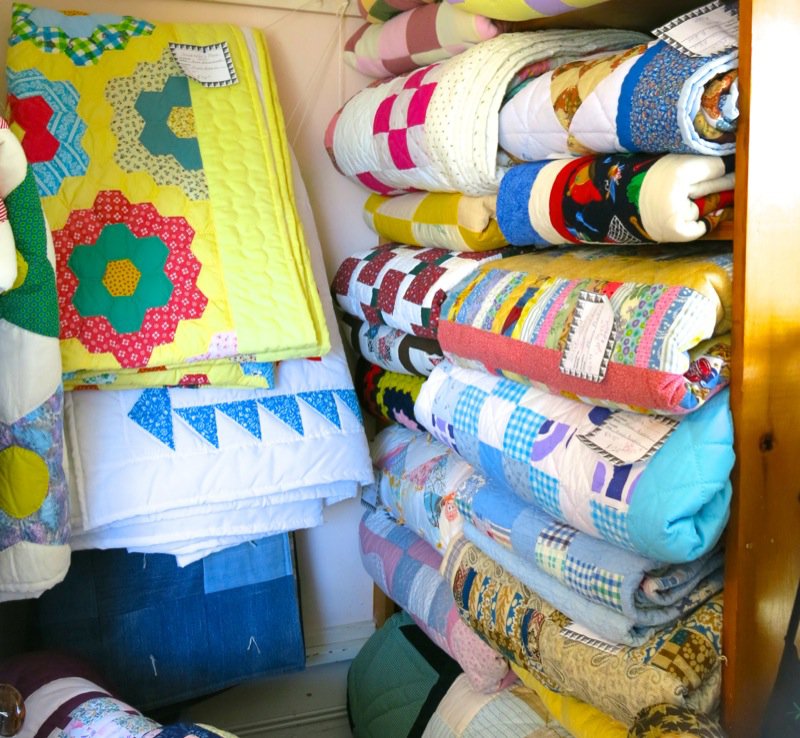
There is a huge assortment of quilts in the gift shop at the Museum.


I could have spent hours here. It was frustrating to not be able to buy some of the treasures I saw. I probably couldn’t afford them, anyway. There is an extensive collection of china and glassware. There are extensive and rare collections in this space of almost everything and anything used in daily living the past 400 years.

Their genealogical archives are recognized by Unesco.

They have one of the most extensive genealogical libraries and the most complete Acadian ancestral library in the world.

The store is fun to shop in… but the most precious treasures are upstairs where Bernice and her co-horts work… for hours and hours …. compiling the genealogical records of the Acadian people.


Above is the research area. Then Bernice opened the vault, below. The special lighting protects the documents. I am still in awe.

Housed here are their extensive genealogical records. The first settlement in Acadia was in 1604, and from that time until the Treaty of Utrecht in 1713, the colony passed back and forth from British to French hands seven times. The Acadians remained neutral during this time. This was possible primarily due to their isolated location; they led productive and peaceful lives not affected by conflict. However, the Acadians were deported to the American Colonies in 1755 and from Pubnico, at the time known as Pobomcoup, from 1756 – 1759 because some Acadian colonies had participated in various military operations against the British during the time after the Treaty of Utrecht. As a result, the British sought to eliminate any future military threat posed by the Acadians by removing them from the area without making distinctions between the Acadians of Pubnico who had been neutral and those who had resisted the occupation of Acadia.

Little physical evidence remains of pre-expulsion Acadia; however, most family names are known from historical documents. Most of these names remain in Acadian Maritime communities providing evidence to the survival of this tenacious community of hard working perseverant people. From 1766-1767 the Acadian people from Pobomcoup relocated back to Pubnico, the anglicized version of Ponomcoup. Pubnico is the oldest Acadian region still occupied by the descendents of its founder.

Most residents of Pubnico today, have direct descendants that have lived here since the 1750’s. The Acadian people of Pubnico today, remain attached to their long-lasting and established way of life, their close knit families and community and an enduring commitment to those who came before as they work to preserve and share their fascinating stories. Pubnico is a unique community with a culture deeply rooted in family ties coupled with a community possessing a shared history: the oldest in Acadian community in Canada, and certainly one of the oldest Canadian communities of any kind. Above, bottom right, is a M’ikmaq basket.

More than half of the 21st century population of Pubnico are descendents of the first couple: Philippe Mius-d’Entremont and his wife. That, alone, is a testament to the pervading idiosyncratic kinship that has emerged in this small village. The community of Pubnico is an obscure gem on the Southernmost tip of Nova Scotia.

The artifacts in their museum are well preserved and some of the most fascinating gadgets I have laid my eyes upon.

The museum garden and way of life in the village enables an intimate simulated life experience here.


Rappie Pie graters of days gone by.

The inside of the round churner, above, is pictured below. What was this used for?


Handmade mashers and moulds.


Spinning wheel set up as if it had just been used….

And whatever is this? It is an egg measuring scale!

And this?

Bernice had me thinking….


Yup. An ice cream scoop. How beautiful!

Each room is set up like a house, as it would be through the years, with precious donations from the families of the village for all to enjoy.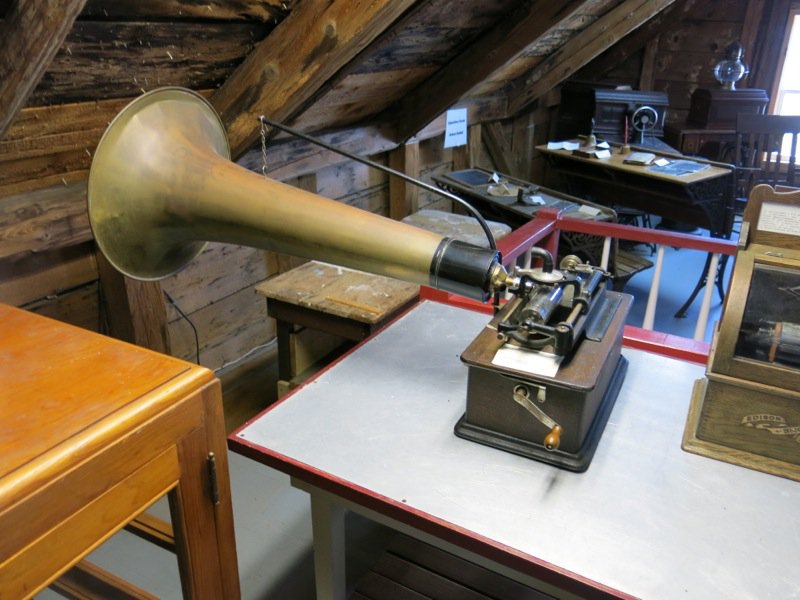
Upstairs houses more artifacts.

Models and toys.

The building is built with wooden pegs.

There were so many tools and impliments, one could spend so much time learning about the innovations over time.

A wooden bicycle wheel! Seriously! To have one remain in such good condition was an honour to see.



The beading of the M’ikmaq.


The pegs above were used in the making of the shoe below. Treasures I have only read about, all preserved here.
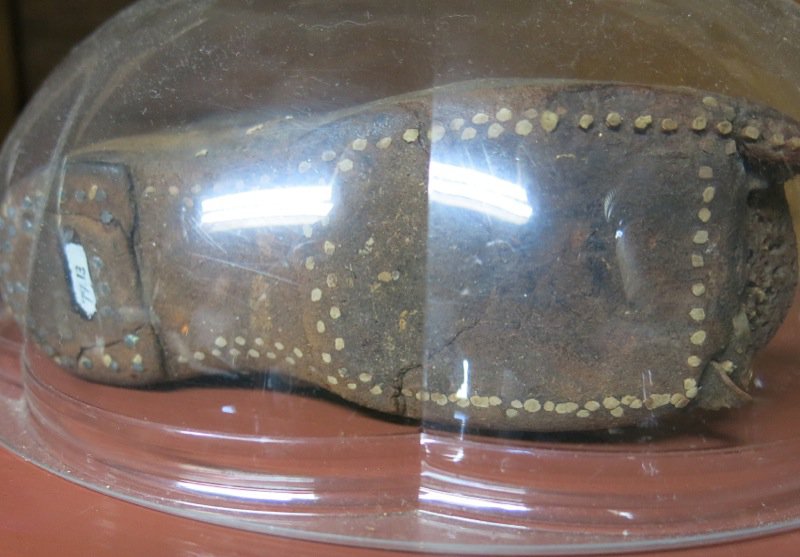


Réal was going to show us how to make the netting for the trap. He is most definitely one of the last of the Acadian fishermen with this knowledge as the traps no longer require hand tied netting.





The ease with which he demonstrated this skill was humbling.




Above, the tools to make the netting. I got to keep the portion of the trap netting he made and I certainly cherish it.


As I said, there is a little of everything here.

The old original mill in the village had long stopped being used. One of the stone grinders was missing from the artifact collection. Réal thought about where it might be, went looking, and found it in the vicinity he had guessed it would be.

This church is still here.

These houses are still here. The descendants of these people – still here. I so appreciated the time Denice d’Eon took, with Bernice, to explain this history to me. I thought I knew it. I thought I understood it. I have taught the history of our Acadian people to my students for years in Edmonton. Yet, what I knew and what I taught was so incomplete. This trip to the Atlantic provinces was much more than a holiday. It was an intimate re-connection with the heritage and history of the people within my own country. An enlightenment of a magnitude completely unexpected… and all from this little obscure village on the Southern tip of Nova Scotia.









Valerie, what an amazing trip this must have been for you, a chance to connect with our Canadian roots in such a delightful manner. I could have spent days in this village, savouring the handmade foods and crafts. Being a fibre artist myself and doing some piecing and quilting I can appreciate the work involved in those gorgeous quilts. I so want to stroke them and examine all the hand stitching, which is becoming a dying art. Hundreds of hours as opposed to a day or two on a sewing machine or a long arm quilting machine. Like using your wonderful Thermomix instead of hand chopping and grinding. Brendi
Great to hear from you, Brendi!
:)V
So happy to hear you enjoyed the biscuits; from my grand-maman,s recipe of course! 🙂
Elaine
Would you be willing to share your recipe? The biscuits were a hit with everyone – and now I am adding your name to the post! Thank you so very much!
Valerie
For sure….I would love too!
Elaine’s Yummy Tea Biscuits
Combine: In a large mixing bowl, 3 cups all purpose flour…4 &1/2 teaspoons baking powder….3/4 teaspoon cream of tartar….2 tablespoons white sugar….pinch of salt
Cut in: 1/2 cup cold shortening and 1/4 cup cold butter or margarine
Mix together: 1 cup of milk and 1 large egg…add to flour mixture and mix until dough holds together …turn out onto a floured board and knead dough very lightly…Roll out to desired thickness ( 1-11/4in approximately) and cut with a biscuit cutter. Bake in a preheated oven at 450* for 12 minutes or until golden brown and flaky!!!
Best when served hot with homemade jams or preserves…but mostly best when shared with good friends and an Alberta Foodie lady!! 🙂
Thank you for this generosity, Elaine. This recipe is considerably different than the one I have made all my life, and I have started a new post for it… and when I make it, I will send you the link. Sincerely appreciate this sharing, and I will definitely pay it forward!
Big hug,
Valerie
Ur most welcome…be sure not to cut the shortening and butter too small…and to not work the dough too much…but then, I,m sure you know that already……you can also add a little more sugar, brush the tops with cream and sprinkle with a little sugar before baking for strawberry or peach shortcakes..
Wonderful tips! This is the first biscuit recipe I have ever seen with an egg…. so I am very interested in making it, but it will be a while, as I am swamped with posts right now.
🙂
Valerie
Good luck and have a good summer!
Elaine
Will look for the post…thx to U!
Hugs..Élaine